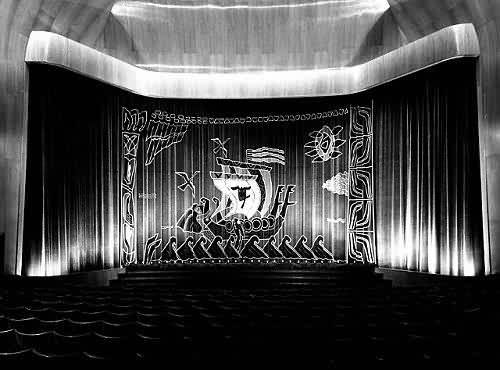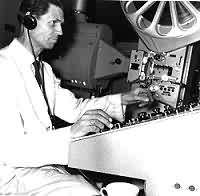DRAKEN
- A brief technical history by Stefan Adler and Magnus Elm

The projection booth on opening day, April 26 1956, 3 Philips FP6, two
of them with 4-channel magnetic sound. The one closest to the camera
is still in use for commercials and trailers when running 70mm, only
now with xenon-lamp and Dolby

The original proscenium opening and the 742 seat auditorium with 12,6
meter CinemaScope screen.

The Cinerama widened proscenium measures a width of more than 20 meters.
The original curtain was left in but widened with a bleached and re-dyed
red velvet curtain.

The original 4-channel stereophonic magnetical and mono-optical amplifier
rack. All equipment including speakers and magnetic transmitter for
hearing impaired was made by Philips

Installing the special Cinerama 20 meter strip-screen in the newly widened
proscenium opening in August 1960.

The booth during the Cinerama days! Left: The modified Philips (Norelco)
FP20 Cinerama projector, for the right hand panel on screen Center:
The Cinerama 7-channel 35mm full coated sound reproducer unit Right:
The standard 35mm FP6

The Cinerama control panel for start, synchronization, focusing and
framing. Right: Second Philips FP6 for standard 35mm. The left hand
panel projector was located behind the electrical switch- and fuseboard
in the next room.

An almost complete view of the Draken Cinerama installation.

The auditorium in the 80´s. Everything, but the Cinerama is intact.
70mm equipment was installed in 1966, making Draken defend its place
as THE bigscreen cinema of Gothenburg! New seats were installed in 1983.

The 70/35mm Zeiss Favorit 70 projectors, with Cinemeccanica 4kW xenon
lamps. The blue control unit to the right is a custom designed audio
switchboard for all the sound formats in use; from 70mm Dolby and down...

A close-up of the Favorit 70 projector head, threaded with 70mm
Draken - Architecture and history
A
complete list of Cinerama/Cinemiracle films shown at Draken
A complete list of 70mm films shown at Draken
Who
is who in the Draken technical history?
Check
out some heavy stuff - the 70mm projectors!
En
maskinist och teknikers bittra kväde över historiens gång
The Swedish Widescreen Menu - Cinerama
- Cinemiracle - Todd-AO - UltraPanavision - SuperPanavision
|
Opening
the 26th of April in 1956, Draken is the last (?) of the BIG theaters
ever built in Gothenburg. No cinema was built after Draken for another
18 years. (Then came a multiplex in a mall!)
By the time of Draken´s opening, CinemaScope, Cinerama and Television,
had overthrown classic cinema design and made screens wider and with
stereophonic sound. The original CinemaScope screen was 12,6 meter,
which was considered a giant screen back then.
Only
after three years in running, the Cinerama and the 70mm Todd-AO had
a breakthrough in Sweden. The Victoria was equipped for 70mm and Draken
for Cinerama. Draken was the only true Cinerama-theater in Sweden, while
Stockholm and Malmoe, each carried one Cinemiracle-installation later
modified for Cinerama. Draken opened its Cinerama with "The Seven Wonders
of the World" December 14, 1960. For a complete list of Cinerama screenings
at Draken, click at bottom of page.
In 1966, Draken was equipped for 70mm projection, with two Zeiss Favorit
70 projectors, still in use today. (screen size approx. 7x15 m) The
first 70mm presentation was the Metro Goldwyn Mayer production of "Operation
Crossbow", followed by a string of major 70mm blockbusters, of which
"Dr Zjivago" showed for more than one year. For a complete list of 70mm
screenings at Draken, click at bottom of page.
The Cinerama sound equipment was modified for 70mm 6-channel stereophonic
sound and was in use until the event of Dolby Stereo in the late 70´s.
The original 2,5 kW Zeiss Xenosol III xenon lamps, running at approx.
85 amps, wasn´t quite sufficient for the screen size, especially since
the number of 70mm releases decreased and we started boosting the 35mm
anamorphic to the same screen width. In 1976 we changed the 2,5 kW´s
to new 4 kW Cinemeccanica Zenith 4000, running at approx. 130 amps.
Now the big screen flooded with light, just as good as in the carbon-arc
days.
It was not only filmwidth declining during the 70´s. The sound was diminished
to a similar degree, with different ways of encoding stereophonic sound
to the optical soundtrack.
Before the breakthrough of Dolby Stereo, we had a brief encounter with
a Hungarian no-name two channel sound system, with absolutely no noise
reduction, nicknamed "Goulash-stereo"! The button on the control panel
is still there and it´s working. This was back in 1978.
In October 1979 Draken was equipped with Dolby Stereo and also new power
amplifiers and new speakers in the auditorium. The first Dolby film
was Riddle Scott´s "Alien" - unfortunately only presented in 35mm Panavision.
By the time of the second Star Wars movie - "The Empire Strikes Back"
- in 1980, the sound equipment was further improved. Special sub-bass
speakers were installed, some years before Dolby discovered the need
for it (!) and separated the lowest bass sound through its own amplifier
system. To avoid power losses and distortion, all speaker cables were
replaced with more stout ones. A wall surrounding the speakers was built
behind the screen and dampened with an old cinema curtain for total
acoustic perfection. The result was tremendous and manifested the cult
status of the theater´s sound system.
The man, responsible for customizing and construction of the sound system,
was Stefan Sjöman of Cinema Electronics. A Gothenburg based service
company to the cinema industry no longer in operation.
The same company, Cinema Electronics, was involved in the customization
of the 70mm sound equipment, two years later in 1982, when the Steven
Spielberg production "Poltergeist" opened in 70mm Dolby Stereo.
In 1988, Draken was promoted "Principal Theater" by Gothenburg Film
Festival. Due to the festival´s special demands, a 16mm high quality
Bauer Selecton dual band studio projector was installed, making it possible
for Draken to host every format and event.
In 1990, Draken got Dolby SR/Spectral recording, first movie shown was
"The Hunt for Red October"
713
brand new seats were installed in the auditorium during summer 1991.
1992, due to Festival needs, the 16mm projector was converted for super-16,
a low-budget format primarily used for blowup to 35mm 1,66:1, rarely
screened in 16mm
In the opening speech of the 1995 Festival, it was announced that Draken,
owned and operated by Svensk Filmindustri /SF, was to be closed down
the coming summer to the benefit of the expanding multiplexes.
SF was willing to leave the cinema to the Gothenburg Film Festival.
SF´s main concern was the seats, newly installed, which could easily
be moved to another cinema. An appeal was directed to the audience,
to raise enough money to buy the seats and save the theater. This turned
out very successful and each one of the 713 seats were sold symbolically
for SEK 1.000! World famous Swedish director, Ingmar Bergman,
was among those buying a seat and rescuing Draken
Between 1995 and 1999, Draken was a Festival theater. and did also serve
as a screening facility for the Swedish Film Institute, with special
events and directed performances to schools, special previews and openings.
Due to the high costs of running such a large and demanding theater.
Without any true commercial screenings, the original owners, the Swedish
Labour Movement - took over the operations in July 1999, with the aim
of running conferences and convents at Draken on a commercial basis.
The possibility of making a commercial success of Draken without blockbuster
movies is to my view somewhat vain. Hopefully someone will come up with
an alternate plan. What about a joint venture with American film distributors?
As
time goes by and we have entered the new millennium, it pretty much
seems like Draken will remain. Except for an occasional screening and
the weekly movie studio activity there are not many shows run, though.
Once a year the Gothenburg Film Festival still revive Draken when it
hosts all the main events during a couple of busy days. (Unfortunately
a main event for an old 70mm projectionist and a main event for a "Dogma-cineast"
are quite apart...)
The
more odd and noteworthy is, that the "new" owners actually
have invested in new state of the art equipment and digital sound -
and actually has kept and renewed the ability to show 70mm, even if
it is only 3 channels behind stage these days. Honor to them for doing
such a wise thing! I surely hope that there will be some commercial
screenings as well in the future - even if the odds for new 70mm prints
seems worse than ever.
What about a joint venture?
The
new equipment was recently installed by Winberg Kino
and my old colleague Ulf Jansson - which from now on puts him in the
"Draken Hall of Fame" and Draken back in the lead of theater
sound in Gothenburg when joining the digital era.
The
heart of the gear is a DOLBY CP500 with active split in the processor
(CAT683) and two CAT701 Digital Readers placed right on top of the analog
magnetic sound units on the 70mm projectors.
70mm/35mm magnetic sound goes through a Dolby MPU unit with CAT91C preamplifiers.
Heavy
listening power is carried out by five LAB1000 power amplifiers
for Left, Center, Right and two sub-bass channels. Surround speakers
are driven by four EA power amplifiers, two for each side of
the stereophonic surround.
All this play through three JBL 4675C-8LF stage speakers and
four JBL 4645C sub-basses. The surround plays through sixteen
JBL 8340A, mounted on the auditorium sides.
Post Scriptum August 2002:
Draken has opened again as a commercial cinema for serving main attractions
for Sandrews/Metronome. All best wishes from the vintage gang!

It is almost half a century since my longtime friend
and colleague projectionist at Draken, Lars Jonsson engineered the first
showings of Cinerama and soon a decade since Draken stopped being a
commercial cinema with regular programming.
Though I believe that cinemas have peaked as distribution form for movies,
I still think there will be a need for exceptional film experiences.
If Draken can avoid demolition in the years to come, who knows...?
BACK!
|











